Filipino Exiles were key in the Anti-Marcos Movement, a big part of Philippine History. They helped form groups like the Katipunan ng mga Demokratikong Pilipino (KDP) and the Coalition Against the Marcos Dictatorship (CAMD). These groups were vital in fighting against Ferdinand Marcos’ rule and pushing for democracy in the Philippines.
The Anti-Marcos Movement was a turning point in Philippine History. Filipino Exiles led the fight for democracy and human rights. They organized protests, boycotts, and other actions to end Marcos’ rule. Their efforts helped spread the word and gather support for the cause.
Key Takeaways
- Filipino Exiles played a crucial role in the Anti-Marcos Movement, a significant part of Philippine History.
- The movement was characterized by the formation of organizations such as the KDP and CAMD.
- Filipino Exiles were instrumental in opposing the dictatorship of Ferdinand Marcos and bringing about democratic change in the Philippines.
- The Anti-Marcos Movement was marked by widespread protests, boycotts, and other forms of activism.
- Filipino Exiles used their skills and resources to mobilize support and raise awareness about the situation in the Philippines.
- The movement ultimately led to the ousting of Marcos and the establishment of a new democratic government in the Philippines.
Historical Context of the Marcos Regime
The Marcos regime is a key part of Philippine History. It started with Martial Law in 1972. This period saw many human rights abuses and economic troubles.
Ferdinand Marcos’ leadership and the political instability of the time helped the regime rise. The declaration of Martial Law was a turning point. It allowed the government to silence opposition and keep control.
The regime’s use of Martial Law reduced crime and fought communist groups in some areas. But, the economy suffered greatly. Workers’ incomes fell, and few farmers got help from land reform.
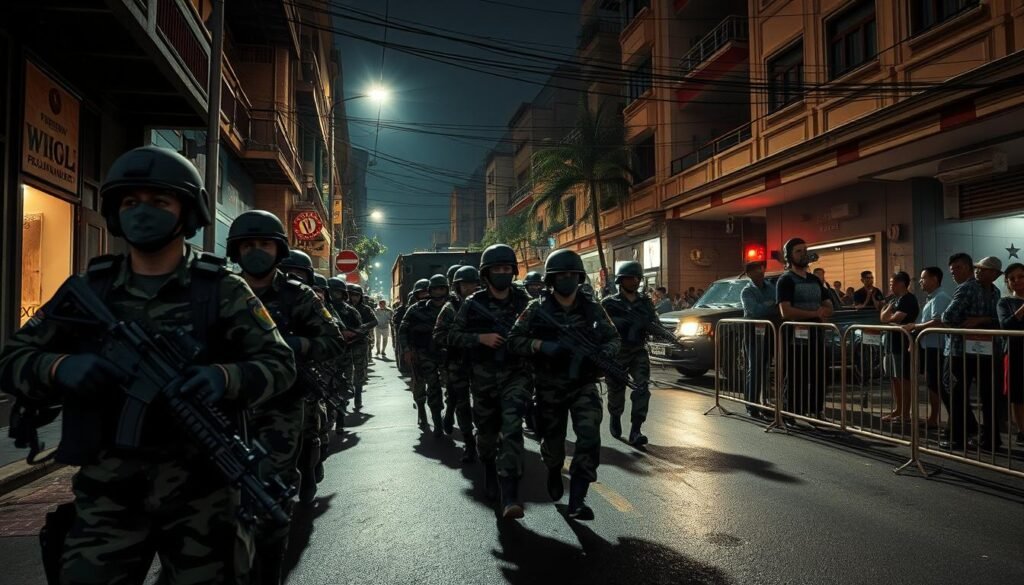
The Marcos regime’s legacy still affects the Philippines today. Many see it as a dark time in the country’s history. The regime’s focus on crony capitalism and corruption has harmed the economy and politics.
Understanding the Marcos regime is crucial for knowing Philippine History. It helps us understand the ongoing challenges faced by the Filipino people.
Understanding Filipino Exiles
The journey of Filipino exiles is complex and varied. It was shaped by their fight against the Marcos regime. Many had to leave their homes in the Philippines and find refuge in countries like the United States.
Adapting to a new place was hard. Yet, they kept pushing for democracy in their homeland. Organizations like the KDP and CJDV were key in supporting them.
These groups helped bring attention to the Marcos regime’s wrongdoings. They made sure the voices of the silenced were heard. This way, Filipino exiles found a sense of community and solidarity, even from afar.
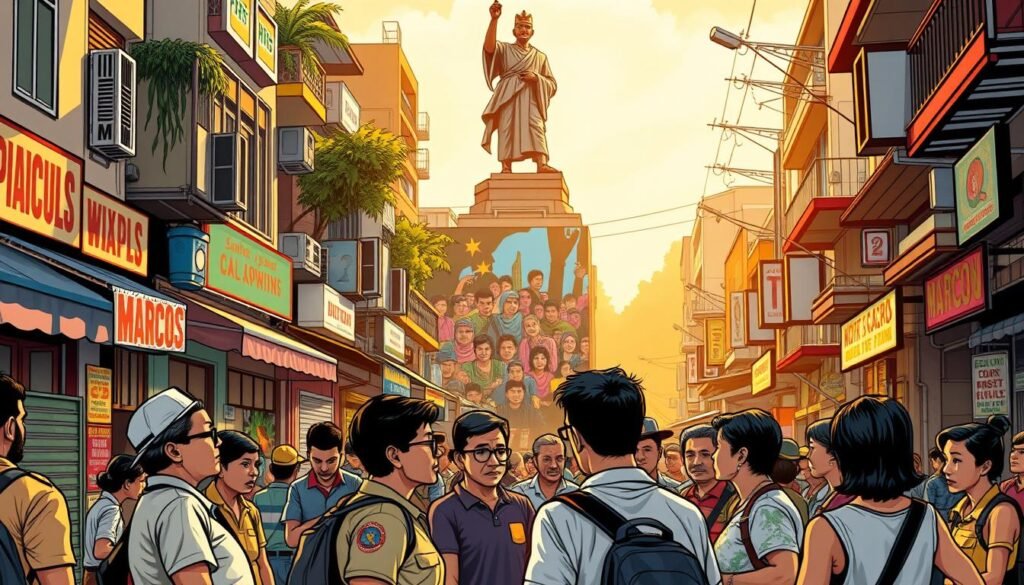
The story of Filipino exiles is one of courage and perseverance. They fought for democracy and human rights, facing many obstacles. Their stories highlight the strength of the Anti-Marcos Movement.
Understanding their experiences helps us appreciate the Filipino diaspora. It shows how it has influenced Philippine history.
Some key aspects of the Exile Experience include:
- Struggles to adapt to a new environment and culture
- Continued involvement in the Anti-Marcos Movement and advocacy for democratic change
- Building of communities and solidarity among Filipino exiles
- Efforts to raise awareness about human rights abuses and injustices in the Philippines
Major Waves of Political Exodus
The Anti-Marcos Movement led to a big Political Exodus of Filipino citizens. This exodus had three main waves. Each wave had its own reasons and characteristics.
The first wave happened from 1972-1975. It was caused by political persecution and Martial Law under Ferdinand Marcos. Many Filipino Exiles went to countries like the United States and Canada for safety and freedom.
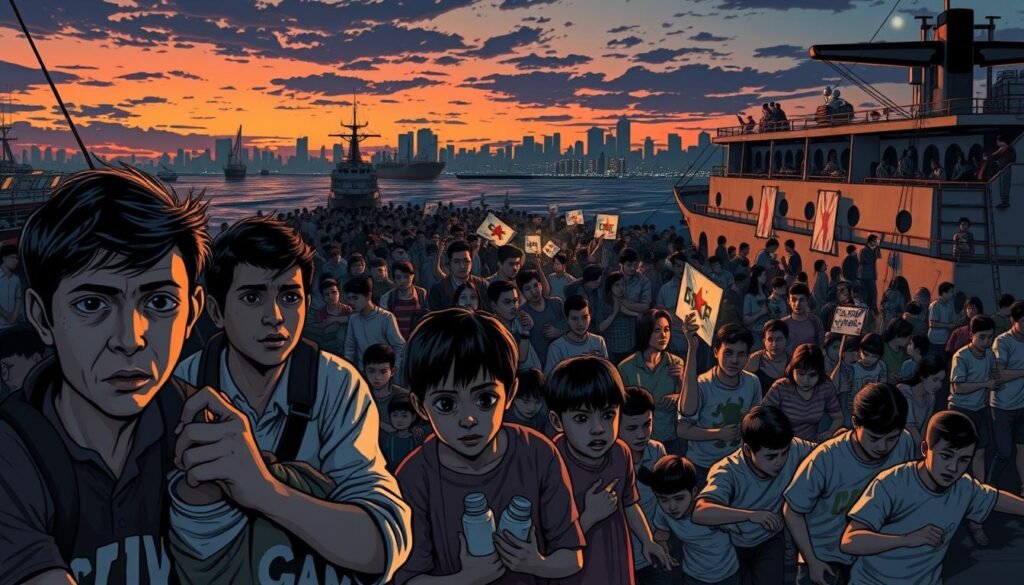
First Wave: 1972-1975
In this time, more Filipino Exiles left, seeking asylum abroad. The Political Exodus grew because of the Marcos regime’s harsh conditions and human rights abuses.
Second Wave: 1977-1980
This wave saw more Filipino Exiles going to places like Europe and Australia. The Anti-Marcos Movement was getting stronger. Many Filipinos wanted to leave the oppressive regime.
Third Wave: 1981-1983
The last wave saw a big rise in Filipino Exiles seeking refuge. The Anti-Marcos Movement had caught the world’s attention. Many countries were ready to give asylum to those fleeing Marcos.
Life in Exile
Life as a Filipino Exile in the United States was tough. Many faced indifference and fear from their community. This was especially true for newer immigrants who focused on finding jobs, homes, and schools.
Groups like the Movement for a Free Philippines (MFP) helped a lot. They offered support and spoke up for the exiles. But, the MFP had its own problems, like disagreements and being seen as too middle-of-the-road. Still, the fight against Marcos kept growing, with exiles working hard to expose the regime’s wrongdoings.
Some key moments in the Exile Experience include:
- The MFP started in Manhattan in September 1973, a year after Marcos declared martial law in 1972.
- Those who supported the MFP faced blacklists, making it hard to speak out against the government.
- The U.S. government, under President Ronald Reagan, was close to Marcos. This affected how exiles and opposition groups were treated.

The Exile Experience was very stressful, as seen in Raoul Beloso’s story. He was a young exile who took his own life in his New York apartment. Despite these hardships, the Anti-Marcos Movement kept pushing for change. They helped close U.S. military bases in the Philippines and changed U.S.-Philippine relations.
International Networks and Support Systems
The Filipino diaspora was key in the Anti-Marcos Movement. Many exiles created International Networks to spread the word and get support. These networks helped form Exile Communities where Filipinos abroad felt a sense of belonging and unity.
Building alliances with foreign supporters was a major strategy. This included working with human rights groups and advocacy organizations. It helped make the voices of Filipino exiles heard and highlighted the Marcos regime’s human rights abuses.
Media campaigns and public relations were also crucial. Exiles used various media to share their stories and raise awareness. This global effort helped bring down the Marcos dictatorship.
The Role of Filipino Exiles in Global Advocacy
Filipino exiles have been key in Global Advocacy, especially in the Anti-Marcos Movement. They’ve worked hard to spread the word about human rights abuses and political persecution in the Philippines. This has helped put pressure on the Marcos regime from around the world.
These exiles have used many ways to get their message out. They’ve done media campaigns, public relations, and built alliances with supporters abroad. Their work has not only raised awareness but also shaped international policies and diplomacy. This has helped bring down the Marcos regime.
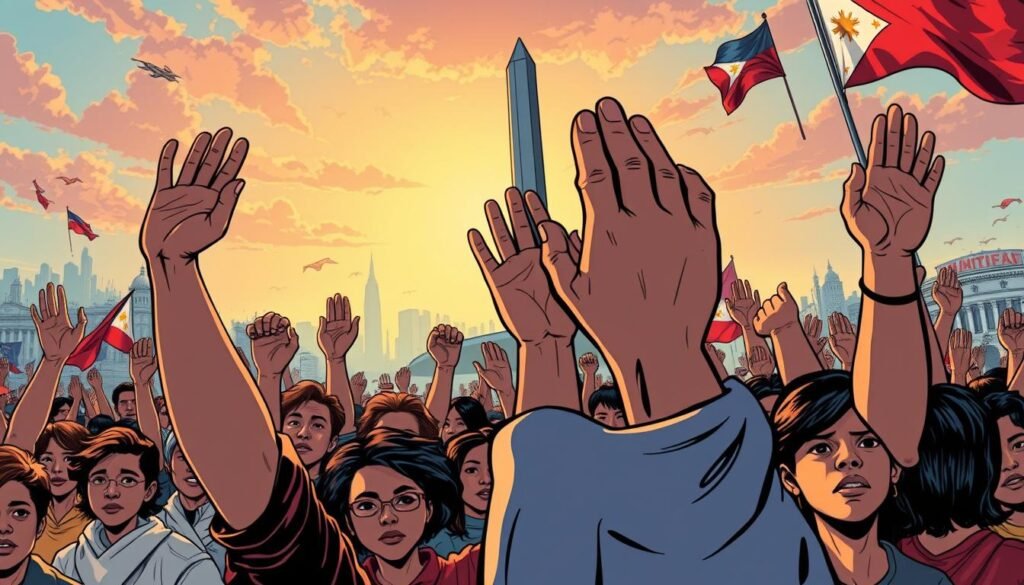
The Filipino Exiles have had a big impact on Global Advocacy. Here’s how:
- They’ve pushed for the Marcos regime to respect human rights and democracy.
- They’ve made more people around the world aware of the Philippines’ political situation. This has grown support for the Anti-Marcos Movement.
- They’ve worked with other international groups. This has strengthened the global support for their cause.
In summary, the Filipino Exiles have made a big difference in Global Advocacy, especially in the Anti-Marcos Movement. Their efforts have not only raised awareness but also shaped international policies and diplomacy. This has helped advance democracy and human rights in the Philippines.
Cultural Resistance and Artistic Expression
The cultural revolution in the Philippines is key to the Anti-Marcos Movement. Cultural Resistance and Artistic Expression are vital tools for change. Through art like literature, poetry, theater, and music, Filipino exiles speak out against Marcos.
Art has been a powerful protest tool. Filipino artists have made works that criticize Marcos and support the Anti-Marcos Movement. Their art has helped raise awareness and gain support.
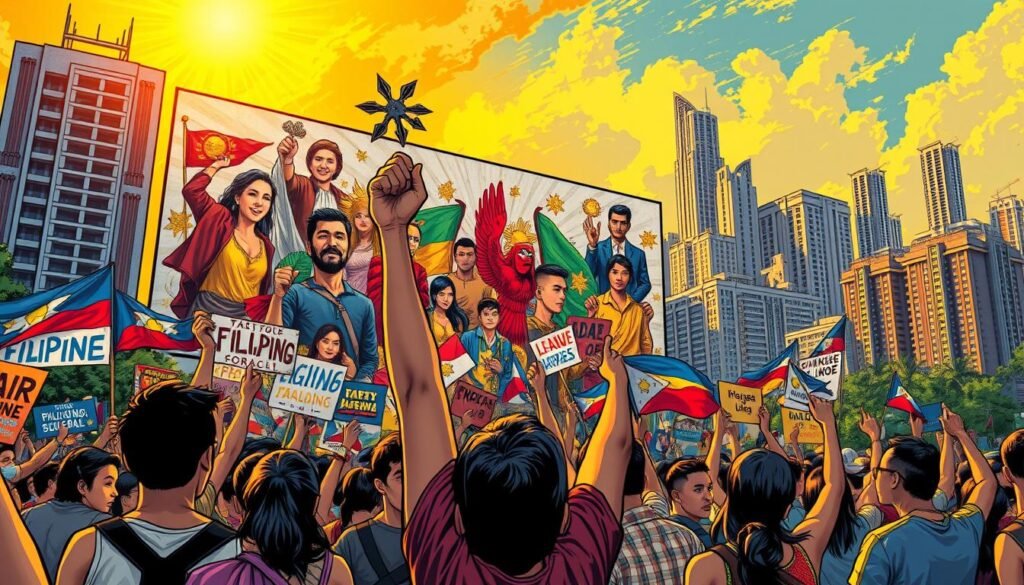
The Anti-Marcos Movement values cultural identity and democratic values. Through art, Filipino exiles have kept their culture alive while fighting for human rights and justice. This focus on cultural resistance and artistic expression has inspired many to fight against Marcos and strive for a fair society.
Impact on International Policy and Diplomacy
The Anti-Marcos Movement made a big splash in International Policy and Diplomacy. It highlighted the human rights abuses and the authoritarian rule in the Philippines. The movement’s work to spread awareness and get support from other countries changed international opinion on the Marcos regime.
This movement changed how the Philippine government interacted with other countries. For instance, the United States, which had backed the Marcos regime, started to pull away. This was due to the growing pressure from the Anti-Marcos Movement and other human rights groups. This change in Diplomacy was a key moment in the movement’s push for change in the Philippines.
Some important events show the Anti-Marcos Movement’s effect on International Policy:
- The creation of the Philippine Commission on Human Rights, set up due to international pressure to tackle human rights abuses.
- The U.S. pulling its economic aid, a big hit to the Marcos regime’s economy.
- Other countries imposing economic sanctions, which further isolated the Marcos regime and weakened its power.

The Anti-Marcos Movement’s influence on International Policy and Diplomacy shows the strength of grassroots movements. Their efforts to raise awareness and get support from other countries led to a shift in International Policy. This shift helped bring down the Marcos regime.
Connection with Underground Movement in Philippines
The Underground Movement in the Philippines was key in the Anti-Marcos Movement. Filipino exiles, part of this movement, teamed up with the underground to fight the Marcos regime. This partnership was vital for the anti-Marcos movement, offering a way to resist and speak out.
The underground movement, with its diverse groups, managed to gather resources and plan actions against Marcos. Thanks to communication networks, they could share information and ideas. Their resource mobilization helped the anti-Marcos movement grow and gain support.
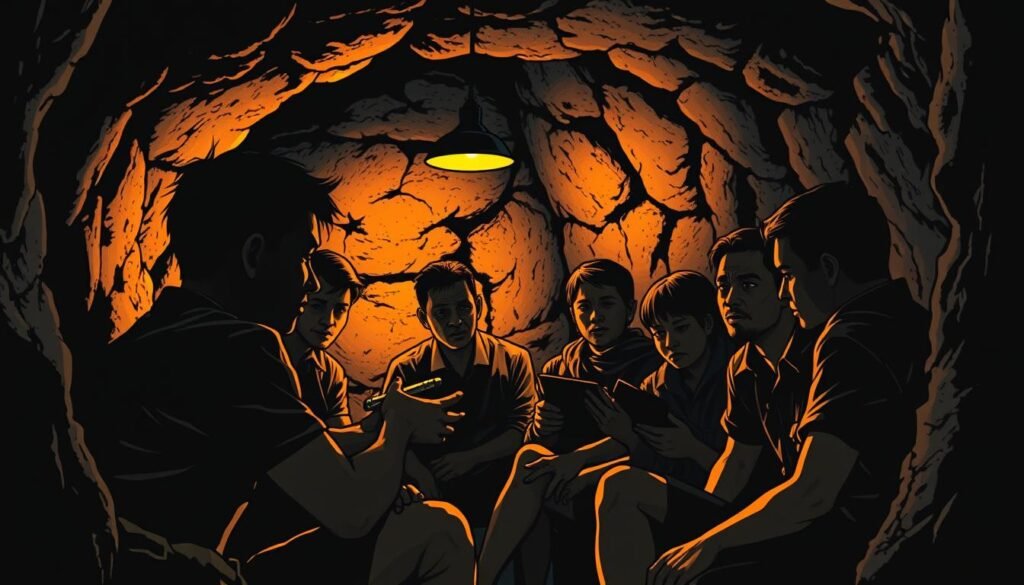
Philippine exiles played a big role in the anti-Marcos movement. They brought international support and pressure on Marcos. The strategic coordination between the underground and exiles made their challenge more effective. Their work drew global attention, helping to bring down the Marcos regime.
The Assassination of Ninoy Aquino: A Turning Point
The killing of Ninoy Aquino on August 21, 1983, was a major turning point. It sparked a national outcry against the Marcos regime. Filipino Exiles were key in responding to the event and pushing for change.
This event hurt the Marcos government’s reputation. It made people see the regime as without a leader.
Several factors made this event so important:
- The brutal killing outraged many and raised conspiracy claims against Marcos.
- Filipino Exiles helped get international support for democracy in the Philippines.
- Corazon Aquino, Ninoy’s wife, became a leader in the Anti-Marcos Movement. She later became president after the People Power Revolution in 1986.
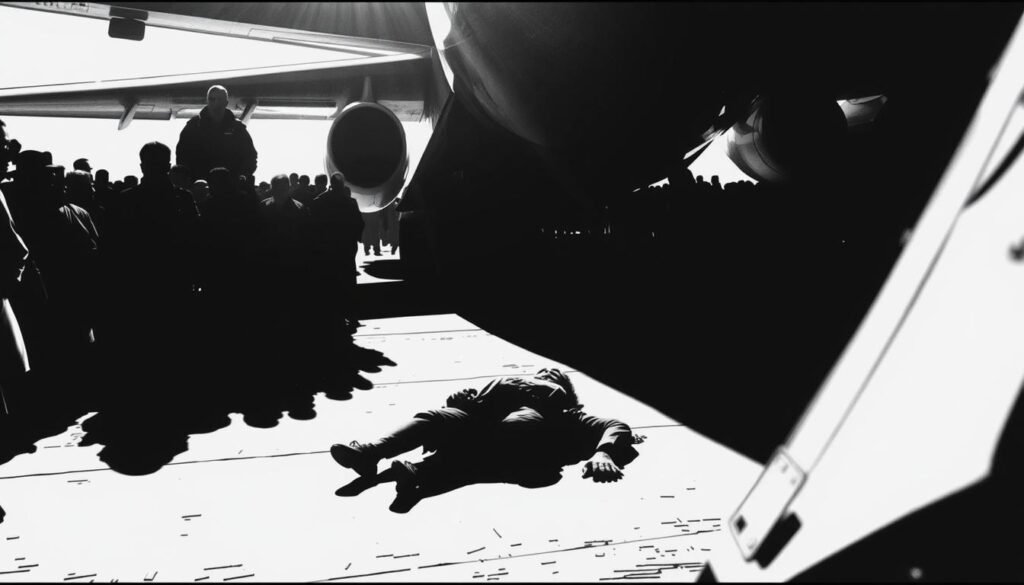
After the assassination, the Philippines’ politics changed a lot. The Anti-Marcos Movement grew stronger. The Marcos regime faced more opposition and scrutiny.
The Filipino Exiles played a big role in this movement. They worked hard to spread the word and support democratic change in the Philippines.
Return from Exile: Stories of Homecoming
The journey of Filipino exiles back to the Philippines shows the tough side of the Anti-Marcos Movement. After years away, they faced big challenges when they came back. Raul S. Manglapus, for example, was in exile for 13 years, 5 months, and 7 days before he was 67.
Many exiles, including those from the 1,000 to 2,000 ‘formal exiles’ during Marcos, found it hard to fit back into society. The economy was in bad shape, making jobs hard to find. Corazon C. Aquino, who was in the U.S. from 1980 to 1983, helped shape the Philippines after Marcos.
Despite the hurdles, many kept fighting for change. The Return from Exile was a new start for them. They wanted to rebuild and make a difference in their country. The stories of Filipino Exiles remind us of the lasting effect of the Anti-Marcos Movement on the Philippines.
Challenges of Reintegration
- Economic struggles
- Social adjustment
- Political involvement
Continued Activism
Many returnees stayed true to democracy and human rights. They kept working for a better Philippines. Their stories show the strength of resilience and determination.
Legacy of the Exile Movement in Modern Philippines
The Legacy of the Filipino Exile Movement still influences the Modern Philippines. Over 10 million Filipinos live in more than 200 countries. This makes the Filipino migrant population huge worldwide. The exile movement has greatly shaped the country’s politics, society, and culture.
The Exile Movement has left a lasting mark on the Modern Philippines. Many Filipinos work abroad and send money back home. Overseas Filipino workers send over $30 billion each year. This money is about 9% of the Philippines’ GDP. The Legacy of the exile movement is seen in the activism of Filipino migrants. They aim to make positive changes in their home country.
Some important facts about the Exile Movement and the Modern Philippines include:
- About 10% of the Philippines’ population works overseas.
- The Filipino diaspora now supports right-wing leaders more. This change is linked to global politics and capitalism shifts.
- Activism among Filipinos abroad has changed. There’s less support for left-wing causes. More people now see the country’s problems as a lack of “discipline” rather than deep issues.
The Legacy of the Exile Movement reminds us of the power of working together. It shows the importance of striving for positive change in the Modern Philippines.
Conclusion: The Enduring Impact of Filipino Exiles on Democratic Change
Philippine exiles played a big role in the fight against Marcos. They worked hard to get international support and organize resistance. This led to the 1986 People Power movement.
This movement was key in removing Marcos and bringing back democracy. It showed the power of people coming together for change.
The history of the Philippines shows the 1986 revolution was a big step towards democracy. It happened during a time when many countries were moving towards democracy.
In February 1987, the Philippines got a new constitution. It was approved by most people, showing they wanted democracy back.
The exile movement’s impact is still felt today. Their fight for democracy is an inspiration. It reminds us of the strength of resistance and the value of democracy.
FAQ
What was the role of Filipino exiles in the anti-Marcos movement?
Filipino exiles were key in the fight against Marcos. They supported the cause internationally. Groups like the KDP and CJDV helped expose human rights abuses in the Philippines.
What was the historical context of the Marcos regime?
Ferdinand Marcos took power in 1965. He declared martial law in 1972. This led to many human rights abuses and forced exile for many Filipinos.
Who were the Filipino exiles and what were their experiences in the United States?
Exiles were those who fled due to political fear. In the U.S., they faced cultural and economic challenges. Yet, they found support in groups like the KDP and CJDV.
What were the major waves of political exodus from the Philippines?
There were three main waves of exile. The first was from 1972-1975, the second from 1977-1980, and the third from 1981-1983. Each wave was driven by persecution, economic hardship, and human rights abuses.
How did Filipino exiles establish international networks and support systems?
Exiles built networks through exile communities and media campaigns. They worked to raise awareness and gain international support for the anti-Marcos movement.
What was the role of Filipino exiles in global advocacy?
Exiles advocated globally for human rights in the Philippines. They lobbied for international support and pushed for reforms in the Philippine government.
How did Filipino exiles use cultural resistance and artistic expression to resist the Marcos regime?
Exiles used literature, poetry, and music to resist Marcos. These forms of expression were powerful tools for critique and social change.
What was the impact of the anti-Marcos movement on international policy and diplomacy?
The movement influenced international policy, pushing for reforms in the Philippines. It also shaped U.S. foreign policy, supporting democratic movements in the Philippines.
How did Filipino exiles connect with the underground movement in the Philippines?
Exiles supported the underground movement through communication and resource mobilization. Their support helped strengthen the resistance against Marcos.
What was the significance of the assassination of Ninoy Aquino?
Ninoy Aquino’s assassination was a turning point. It drew global attention and increased pressure for reforms in the Philippines.
What were the challenges faced by Filipino exiles who returned to the Philippines?
Returning exiles faced challenges like reintegration and personal safety. Yet, they played a key role in shaping the post-Marcos era and promoting reforms.
What is the legacy of the exile movement in modern Philippines?
The exile movement’s legacy is one of activism, advocacy, and justice. It promoted reforms, human rights, and social justice, inspiring future movements in the Philippines.
Source Links
- Coalition Against the Marcos Dictatorship
- The People Power Revolution, Philippines 1986
- Philippines – Martial Law, Marcos, Dictatorship | Britannica
- On Martial Law at 50: Fact-Checking the Marcos Story, Countering the EDSA History | Heinrich Böll Foundation | Southeast Asia
- The End of an Era — Handholding Ferdinand Marcos in Exile – Association for Diplomatic Studies & Training
- Philippines-Marianas Relations in History: Some Notes on Filipino Exiles in Guam
- “America’s St. Helena”: Filipino Exiles and U.S. Empire on Guam, 1901–03
- History of Philippine migration
- How Pinoys in exile in the US helped topple a dictator
- How the Left Organized the Filipino Diaspora
- 6aguila-the filipino, diaspora.pmd
- Nationalizing Transnationalism? The Philippine State and the Filipino Diaspora
- WWII: A Philippine government in exile
- ‘I am safer in Hong Kong’: Transimperial entanglements in Filipino nationalist explorations | Modern Asian Studies | Cambridge Core
- Propaganda Movement | Facts, Definition, & History | Britannica
- Artist as Citizen: Transnational Cultural Work in the National Democratic Movement of the Philippines
- Global Aestheticscapes: Re-imag(in)ing the Global Experiences of Selected Filipino Artists Through Their Installation Artworks
- ArtAsiaPacific: Art in Exile: Interview with Carlos Celdran
- A Sea of Troubles: The Philippines and Pacific Geopolitics
- Revolutionary Exile: The Hong Kong Junta and Filipino Independence
- Hukbalahap Rebellion | Filipino History, WWII Resistance | Britannica
- Martial Law and Its Aftermaths: A Personal History
- Philippine National Independence, 1898–1904 (Chapter 12) – East Asia in the World
- I saw the tarmac murder that haunts the Philippines 40 years later
- Assassination of Aquino linked to power struggle for successor to Marcos
- THE RETURN OF AN EXILE: ‘IT’S THE GREATEST STORY’ (Published 1986)
- LOOK BACK: The Marcos family’s exile in Hawaii after the 1986 EDSA uprising
- How the Left Organized the Filipino Diaspora
- Philippine Revolution | Facts, Leaders, & Significance | Britannica
- The Constitution of the Philippines and transformative constitutionalism | Global Constitutionalism | Cambridge Core

